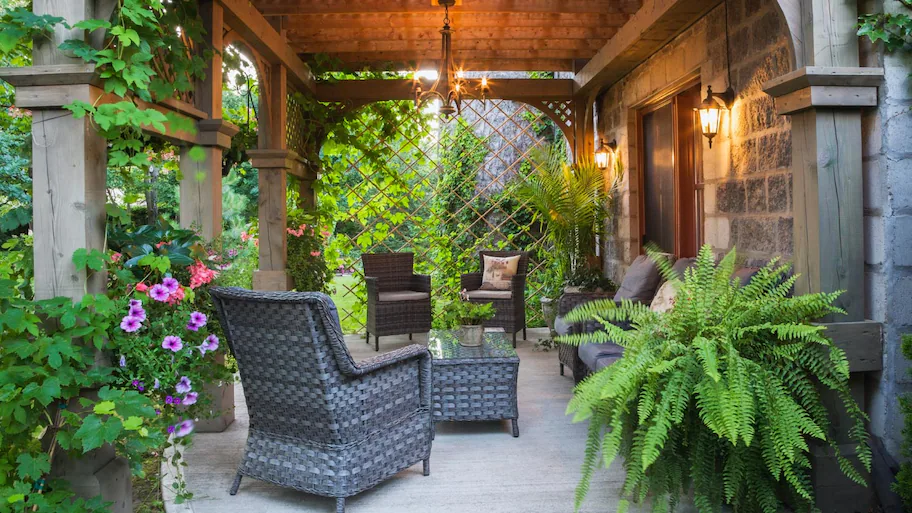What are the Benefits of Blocking the Sun on Your Patio?
Are you considering adding shade to your patio space? There are many benefits to blocking the sun on your patio, from increased comfort to protection from harmful UV rays.
One of the biggest advantages of adding shade to your outdoor space is the increased comfort it provides. By blocking the sun’s rays, you can create a cooler and more pleasant atmosphere for relaxing and entertaining. This is especially important during the summer months when temperatures can soar and direct sunlight can make it difficult to spend extended periods of time outdoors.
Another important benefit of blocking the sun on your patio is the protection it provides from harmful UV rays. Exposure to UV radiation can increase your risk of skin cancer and premature aging, so it’s important to take steps to limit your exposure when spending time outdoors. By adding shade to your patio, you can reduce your risk of UV damage and enjoy the outdoors safely.
Adding shade to your patio can also help to extend the life of your outdoor furniture and decor. Direct sunlight can cause fading and damage over time, so blocking the sun can help your patio decor to last longer and stay looking great.
There are many options for adding shade to your patio, from retractable awnings to sun shades and sail shades. You can even create your own shade solutions using fabric coverings, pvc pipe, or natural materials like thatched roof or mature trees.
No matter what solution you choose, adding shade to your patio is a smart investment that will provide many benefits for years to come. So why not start enjoying your outdoor space in comfort and safety today?
What Are My Options for Sun Blocking Solutions?
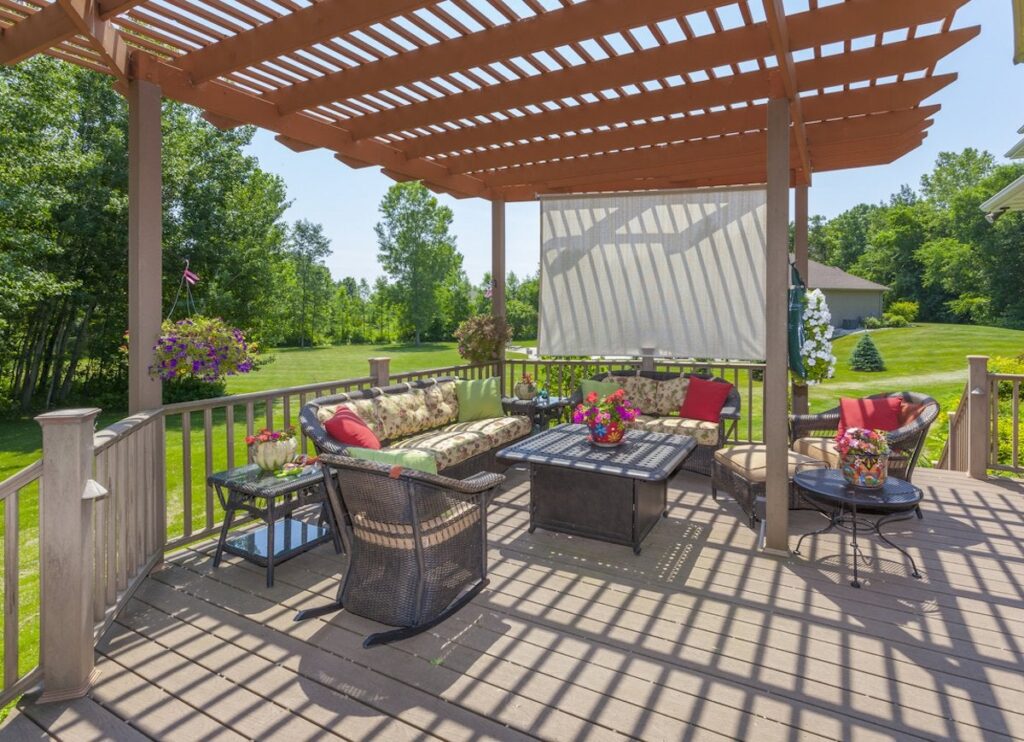
When it comes to enjoying your outdoor spaces, protecting yourself from the sun’s rays is always an important consideration. Whether you’re lounging on your patio or relaxing by the pool, prolonged exposure to sunlight can have damaging effects on your skin and overall health. Fortunately, there are plenty of sun-blocking solutions that can help keep you safe, comfortable, and shaded.
One popular solution for blocking the sun’s rays is a retractable awning. These portable structures can be mounted to your home’s exterior, providing a shady retreat whenever you need it. With a push of a button, you can easily extend or retract the awning to adjust the amount of shade you need. Retractable awnings come in a variety of colors and styles, so you can choose the look that best suits your outdoor space.
Another popular option for blocking the sun is a shade sail. These large, triangular pieces of fabric are installed using anchor points on your home and in the ground. Shade sails come in a variety of colors and designs, making them a great option for adding a pop of style to your outdoor space. They’re also easy to install and can be adjusted to provide just the right amount of shade.
Outdoor curtains are another great way to block the sun’s rays. These curtains come in a variety of styles and colors and can be hung on a rod or wire to provide a stylish and effective sun-blocking solution. Outdoor curtains can also add a sense of privacy to your outdoor space and can be especially helpful if you have close neighbors.
Sun shades are another popular option for blocking the sun on your patio or outdoor space. These retractable screens are designed to block out the sun’s rays while still allowing in natural light and air. They’re easy to install and come in a variety of colors and designs to match your outdoor decor.
Of course, the natural solution to blocking the sun is to plant trees and create shaded areas using plants. This can be a more time-consuming and long-term solution, but it’s also one of the most beautiful. Trees and plants not only provide shade but also act as natural air filters, improving the air quality in your outdoor space.
Regardless of the sun-blocking solution you choose, it’s important to prioritize protection from harmful UV rays whenever you’re spending time outdoors. With so many options available, there’s no reason to let the sun keep you from enjoying your outdoor spaces. Choose the solution that works best for you and enjoy the shade!
Retractable Awnings
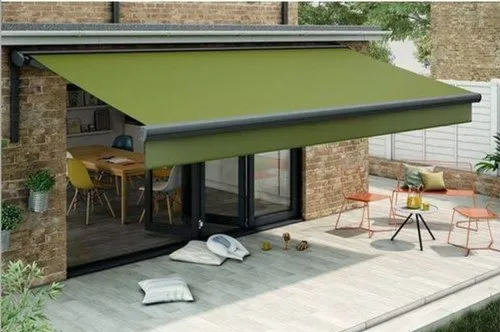
Retractable awnings are a popular option for homeowners who want to block the sun’s rays from their outdoor spaces. These portable structures offer a versatile and effective way to create shade whenever you need it. With just the push of a button, you can easily extend or retract the awning to adjust the amount of shade you want.
Retractable awnings come in a variety of styles, colors, and sizes, so you can choose the perfect fit for your patio or outdoor living space. They can be mounted to the exterior of your home, providing seamless coverage and protection from the sun’s harmful UV rays. Some models even come with weather sensors, which can automatically retract the awning in high winds or heavy rain to protect the fabric.
One of the key benefits of retractable awnings is their versatility. They can be adjusted to provide shade during the hottest part of the day and then retracted for unobstructed views of the sky at night. They can also be angled to block the sun’s rays while still allowing natural light to filter through, giving you the freedom to create the perfect outdoor environment for lounging, entertaining, or dining.
Retractable awnings are also easy to install and maintain. They require minimal upkeep and can be cleaned with a simple solution of mild soap and water. With proper care, the fabric on your retractable awning can last for many years, providing long-lasting protection and shade for your outdoor space.
Overall, retractable awnings are a versatile and effective solution for blocking the sun’s rays on your patio or outdoor living space. With a wide range of styles and options available, you can find the perfect fit for your home and enjoy a comfortable, shaded retreat all season long.
How Do Retractable Awnings Work?
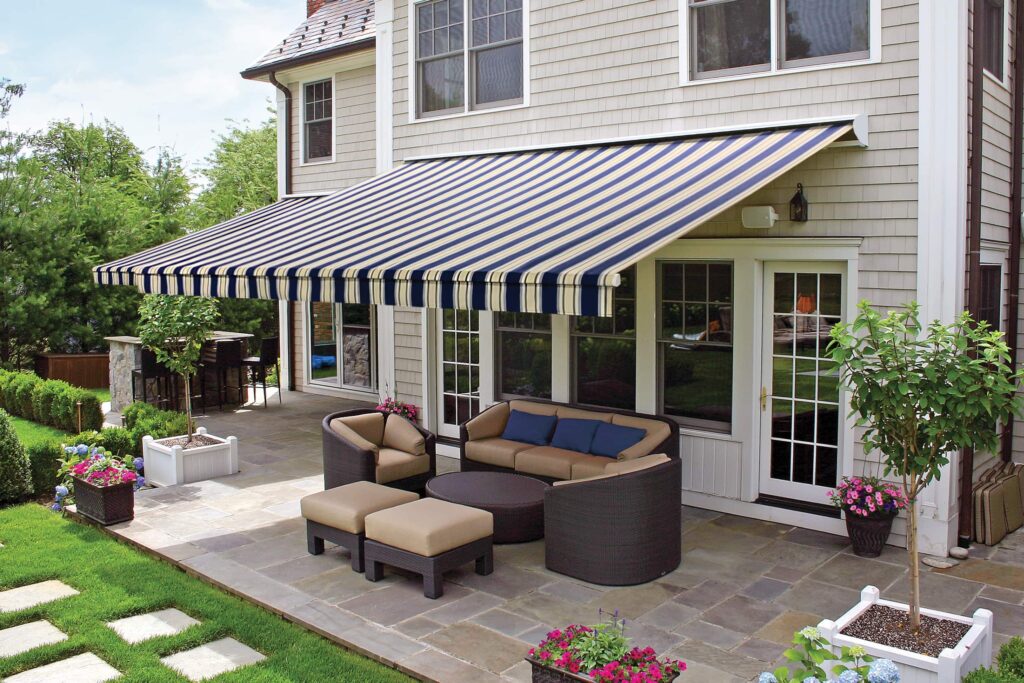
Retractable awnings are an excellent addition to any outdoor living space because they provide shade and protection from the sun’s harmful rays. But have you ever wondered how these innovative devices actually work? In this article, we’ll explore the mechanics behind retractable awnings and how they function to deliver shade and comfort in any environment.
First, let’s define what we mean by a retractable awning. Simply put, a retractable awning is a shading system consisting of a fabric cover stretched over a metal frame, which can be retracted and extended as needed. The awning is typically mounted to the exterior of a building, such as a house or commercial property, and can be controlled manually or with a motorized mechanism.
When you activate your retractable awning (whether via a hand crank or a motorized control), the gears inside the mechanism begin to turn, leading to the extension of the fabric cover. The parts of the awning that are responsible for retracting the cover are typically stored inside a protective casing when not in use.
The exact mechanism of retractable awnings can vary depending on the type you select. Some awnings extend outward until they lock into place, while others work by rolling the fabric out and back in again. Additionally, some retractable awnings come with weather sensors that detect high winds or heavy rain and automatically retract the awning to prevent damage to the structure or fabric.
Thanks to their versatility, retractable awnings can be angled to block the sun’s rays while still allowing natural light to filter through. This is an especially useful feature for homeowners who want to maintain a level of brightness and natural warmth on their patio or deck without being blinded by direct sunlight.
Finally, it’s important to note that retractable awnings require maintenance and upkeep to remain safe and effective. Most manufacturers recommend cleaning the fabric cover with a mild soap and water solution at least twice a year to prevent mold, mildew, and other types of damage. You’ll also want to inspect the mechanism periodically to ensure it’s functioning properly and make any necessary repairs.
Overall, retractable awnings are an excellent way to add practical and aesthetic value to your outdoor space. With their simple yet innovative mechanisms, it’s no wonder that they’ve become such a popular choice among homeowners and business owners alike.
Pros and Cons of Retractable Awnings
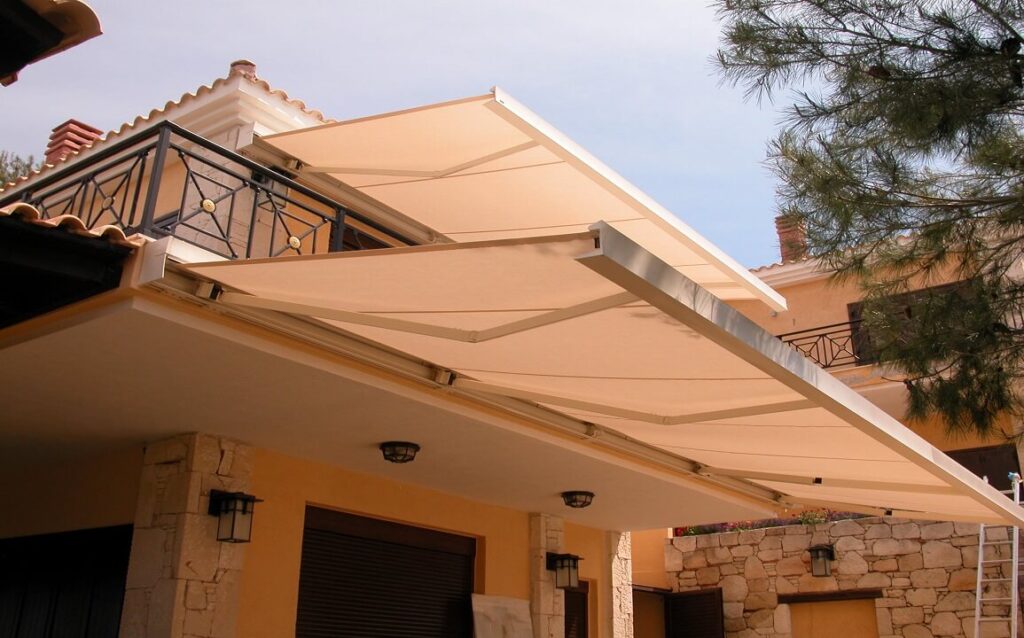
Retractable awnings have become increasingly popular for providing shade and protection from the sun’s rays on patios, decks, and other outdoor living spaces. While there are many benefits to using retractable awnings, there are also some potential drawbacks to consider. Let’s take a closer look at the pros and cons of retractable awnings.
Pros:
1. Versatility: One of the biggest advantages of retractable awnings is their versatility. They can be extended or retracted as needed, providing shade and comfort when the sun is high or allowing in more natural light when desired.
2. Energy savings: Retractable awnings can help reduce energy costs by blocking direct sunlight during the hottest part of the day. This can help keep your home or outdoor living space cooler, reducing the need for air conditioning and lowering your energy bills.
3. Protection from the elements: Retractable awnings can provide protection from the rain, wind, and other elements, allowing you to enjoy your outdoor living space no matter what the weather.
4. Increased property value: Adding a retractable awning to your home can increase its resale value, as it adds both functionality and aesthetic appeal.
Cons:
1. Maintenance: While retractable awnings require less maintenance than traditional fixed awnings, they still require periodic cleaning and inspection to ensure they are functioning properly.
2. Potential damage: Retractable awnings can be damaged by high winds, heavy rain, and other severe weather conditions, so it’s important to retract them in these situations to avoid damage.
3. Expense: Retractable awnings can be more expensive than traditional fixed awnings and other shade solutions, which may not be feasible for all homeowners.
4. Limited lifespan: The lifespan of a retractable awning can vary depending on the quality of the materials and regular maintenance. However, even the best retractable awnings will need to be replaced eventually, which can be costly.
In conclusion, retractable awnings offer many benefits for homeowners looking to enhance their outdoor living spaces. However, like any home improvement project, it’s important to weigh the pros and cons before investing in a retractable awning to ensure it meets your needs and fits your budget.
Shade Sails and Cloth
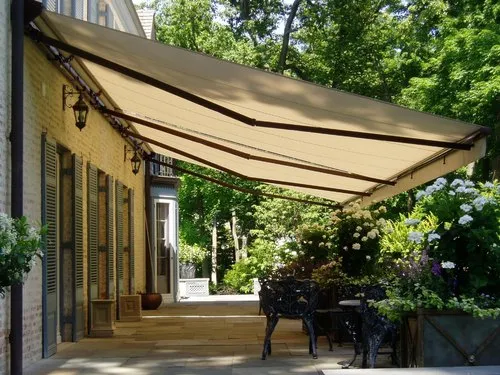
Shade sails and cloth have become increasingly popular in recent years for their affordability and versatility in providing shade to outdoor spaces. These modern shade solutions come in a variety of styles and colors, making it easy to find the perfect one to match the aesthetics of your home or outdoor living space.
Shade sails are made of durable fabric that is stretched between anchor points to create a shaded area. They are a great option for those who want to add shade to their patio or backyard without the expense of installing a permanent structure. They can also be easily taken down and stored during the off-season, making them a convenient solution for seasonal shade needs.
Shade cloth is another affordable option that offers a lightweight and flexible way to add shade to an outdoor area. This type of shading material is made from a knitted polyethylene fabric that is designed to block up to 90% of harmful UV rays. It is commonly used to cover pergolas, carports, and greenhouses, but can also be used to create a shaded area in a backyard or patio.
One of the main advantages of shade sails and cloth is their ability to provide shade without blocking the view. Unlike traditional pergolas or awnings, they allow for a more open and airy environment while still providing protection from the sun. They also come in a variety of shapes and sizes, allowing you to customize the amount of shade you need for your specific outdoor space.
When it comes to installation, both shade sails and cloth can be set up easily by following detailed instructions or hiring a professional installer. They also require minimal maintenance, with occasional cleaning to remove dust or debris being the only necessary upkeep.
In addition to providing shade, shade sails and cloth can also enhance the aesthetics of your outdoor space. They come in a wide range of colors and patterns, giving you the ability to customize the look of your shading material to match your personal style.
Overall, shade sails and cloth provide an affordable and flexible solution for creating shade in outdoor spaces. Their versatility, ease of installation, and customizable options make them an attractive option for anyone looking to add shade to their backyard or patio.
What is a Shade Sail or Cloth?
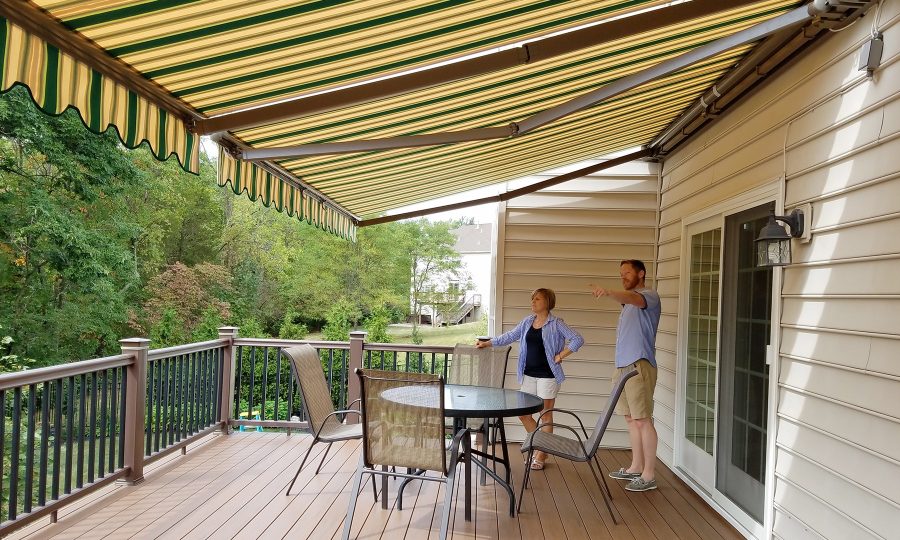
A shade sail or cloth is a versatile and cost-effective way to add shade to your outdoor space. Made from durable fabric, they are stretched between anchor points to create a shaded area that provides protection from the sun’s harmful rays.
One of the main advantages of shade sails and cloth is their versatility. They come in a wide variety of shapes, sizes, and colors, allowing you to customize the amount of shade and the look of your outdoor space. This makes them an excellent choice for a range of outdoor areas, from patios and decks to playgrounds and picnic areas.
Shade cloth is typically made from a knitted polyethylene fabric that is designed to block up to 90% of harmful UV rays. It is lightweight and flexible, making it an ideal option for use in a variety of settings. Shade sails, on the other hand, are made from a thicker, more durable fabric that is designed to withstand the elements.
One of the key benefits of shade sails and cloth is their easy installation. With detailed instructions, they can be set up in just a few hours, making them a convenient solution for those who are looking to add shade to their outdoor space without the expense and hassle of installing a permanent structure.
Another advantage of shade sails and cloth is their low maintenance requirements. Occasional cleaning to remove dust and debris is all that’s needed to keep them in good condition. They can also be easily taken down and stored during the off-season, making them a convenient and practical choice for seasonal shade needs.
Overall, shade sails and cloth are a versatile and affordable way to add shade and enhance the aesthetics of your outdoor space. With a range of sizes, shapes, and colors to choose from, they offer a convenient and practical solution for anyone looking to create a shaded area in their backyard, patio, or outdoor living space.
Pros and Cons of Shade Sails and Cloth
When it comes to adding shade to your outdoor space, shade sails and cloth can be excellent options. However, like any product, they have both pros and cons that should be considered before making a final decision.
Pros of Shade Sails and Cloth:
1. Customization: One of the biggest advantages of shade sails and cloth is their versatility. They come in a wide variety of shapes, sizes, and colors, allowing you to customize the amount of shade and the look of your outdoor space. This makes them an excellent choice for a range of outdoor areas, from patios and decks to playgrounds and picnic areas.
2. UV Protection: Shade cloth is typically made from a knitted polyethylene fabric that is designed to block up to 90% of harmful UV rays. This can be especially important if you or your family members spend a lot of time outdoors and are concerned about sun damage.
3. Easy Installation: One of the key benefits of shade sails and cloth is their easy installation. With detailed instructions, they can be set up in just a few hours, making them a convenient solution for those who are looking to add shade to their outdoor space without the expense and hassle of installing a permanent structure.
4. Low Maintenance: Another advantage of shade sails and cloth is their low maintenance requirements. Occasional cleaning to remove dust and debris is all that’s needed to keep them in good condition. They can also be easily taken down and stored during the off-season, making them a convenient and practical choice for seasonal shade needs.
Cons of Shade Sails and Cloth:
1. Durability: While shade sails and cloth are designed to withstand the elements, they may not be as durable as some permanent structures. Wind, rain, and snow can all take a toll on the fabric over time, and you may need to replace it more frequently than you would with a permanent structure.
2. Limited Protection: Depending on the size and placement of your shade sail or cloth, it may not provide complete protection from the sun or rain. You may need to add additional shade solutions or use it in conjunction with other outdoor structures to provide the level of coverage you need.
3. Aesthetics: While shade sails and cloth can be customized to your preferred color and style, some may not find them as visually appealing as other shaded structures. If aesthetics are important to you, it may be worth exploring other options, such as a thatched roof or retractable awning.
4. Cost: While shade sails and cloth can be less expensive than other shade solutions, the cost can add up if you need to replace the fabric frequently or if you need multiple sails or pieces of cloth to cover your desired area.
Overall, shade sails and cloth can be excellent options for those looking to add shade to their outdoor space. Consider the size and placement of your desired shade solution, as well as your budget, maintenance needs, and aesthetic preferences, to determine whether this option is the best fit for you.
Outdoor Curtains & Sun Shades
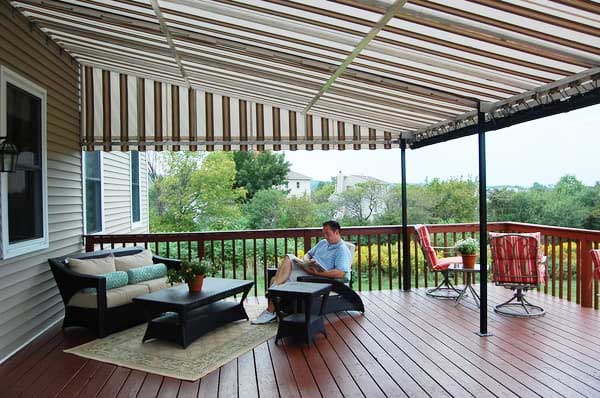
If you’re looking for an easy and affordable way to block the sun on your patio, outdoor curtains and sun shades are worth considering. These popular shade solutions come in a variety of styles, materials, and colors to suit any outdoor space and personal preference.
One of the benefits of outdoor curtains is that they provide privacy as well as shade. Made from weather-resistant materials like polyester, acrylic, or Sunbrella fabric, outdoor curtains are designed to withstand harsh weather conditions. They’re available in various lengths and can be hung using grommets, tabs, or rod pockets for a polished look. Outdoor curtains are also easy to install and remove, making them a convenient option for seasonal shade needs.
Sun shades are another option to consider when you’re looking to block the sun on your patio. These shade structures usually consist of a fabric panel that is stretched over a frame or mounted to a wall. Sun shades are available in a range of sizes and styles, from retractable shades that can be controlled with a remote to fixed shades that provide permanent coverage.
One of the advantages of sun shades is that they allow some light to filter through, creating a soft and ambient atmosphere on your patio. They can also be customized with a variety of materials, such as shade cloth, mesh, or canvas, to match your outdoor decor. Sun shades are typically made from UV-resistant fabric, which protects you from harmful sun rays and reduces heat buildup on your patio.
While outdoor curtains and sun shades have their advantages, they also have some limitations. For example, they may not provide as much coverage as other shade solutions, such as retractable awnings or shade sails. They also require some maintenance, such as periodic cleaning to prevent mold and mildew buildup.
Despite these considerations, outdoor curtains and sun shades remain popular shade solutions for those looking to block the sun on their patio. With their affordability, convenience, and stylish appearance, they can help transform any outdoor space into a comfortable and relaxing oasis.
What are Outdoor Curtains & Sun Shades?
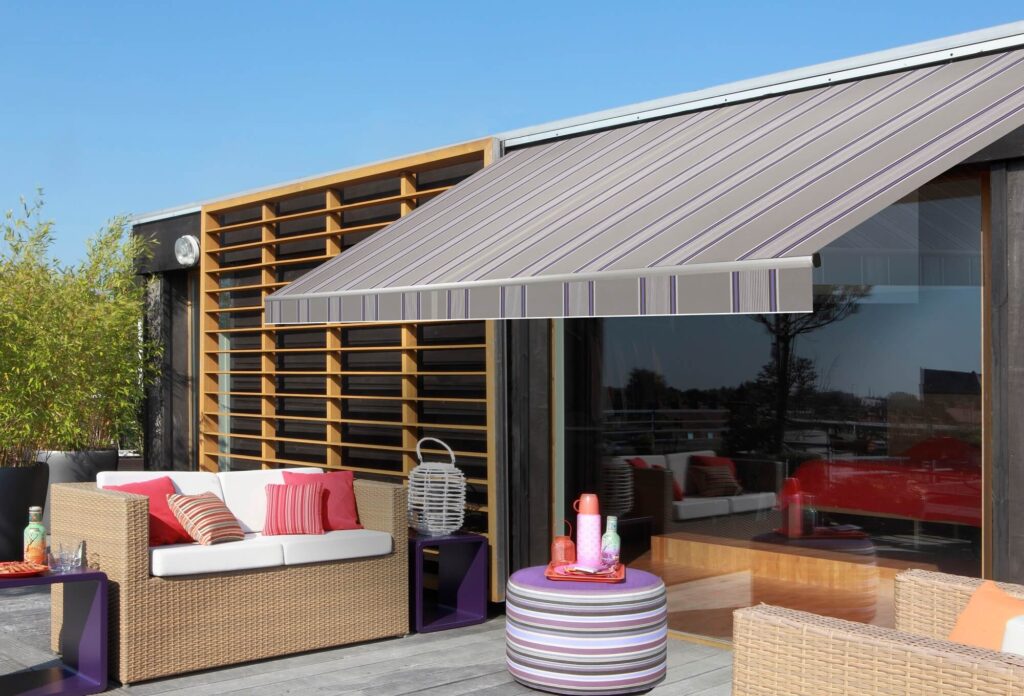
Outdoor curtains and sun shades are two of the most popular shade solutions for patios, decks, and other outdoor living spaces. Both options offer a great way to block the sun’s harsh rays while providing privacy and creating a relaxing ambiance on your patio.
Outdoor curtains, as their name suggests, are curtains specifically designed for outdoor use. They are made from materials that are weather-resistant, such as acrylic, polyester, or Sunbrella fabric, which are designed to withstand the effects of weather and UV rays. These curtains come in a variety of styles and lengths, offering a customizable solution for any outdoor space.
One great advantage of using outdoor curtains is that they allow for flexibility in terms of placement and installation. They can either be hung using tabs, grommets, or rod pockets, and they can also be easily taken down and stored away during colder months. This option offers the perfect balance between privacy and air circulation, allowing you to enjoy your outdoor space without feeling boxed in.
On the other hand, sun shades are another popular option for blocking the sun’s rays outside the home. They are made from a fabric panel stretched over a frame or mounted to a wall to provide shade, light diffusion, and some privacy. Sun shades are available in a range of sizes and styles, from retractable shades that can be controlled with a remote to fixed shades that provide permanent coverage.
One of the benefits of sun shades is that they come in a range of materials, such as shade cloth, mesh, or canvas, allowing you to customize them to fit your outdoor decor. They are typically made from UV-resistant fabric, which helps to reduce heat buildup and protect you from harmful sun rays. Another great advantage of sun shades is that they help to create a soft and ambient atmosphere on your patio by allowing some light to filter through.
Overall, both outdoor curtains and sun shades offer a great way to add much-needed shade and privacy to your outdoor living space. While they come with limitations, these shade solutions are versatile and easily customizable, making them an excellent choice for any homeowner looking to enhance their outdoor living experience.
Pros and Cons of Outdoor Curtains & Sun Shades
Outdoor curtains and sun shades are popular options for blocking the sun’s rays and creating a comfortable outdoor space. However, both options have their own set of pros and cons that may influence which one is right for your needs.
Let’s start with outdoor curtains.
Pros:
1. Flexibility & Customization: Outdoor curtains are available in a variety of styles, lengths, and materials, making them a customizable solution for any outdoor space. They can be easily hung using tabs, grommets, or rod pockets, and can be taken down and stored away during colder months.
2. Privacy & Airflow: Outdoor curtains offer the perfect balance between privacy and air circulation, allowing you to enjoy your outdoor space without feeling boxed in. You can easily open or close them to adjust the level of privacy or airflow.
3. Weather-Resistance: These curtains are made from weather-resistant materials, such as acrylic, polyester, or Sunbrella fabric, which can withstand the effects of weather and UV rays.
Cons:
1. Limited Sun Protection: While outdoor curtains can offer some sun protection, they do not provide as much coverage as sun shades. They may also not be effective against direct sunlight during certain times of the day.
2. Maintenance: Outdoor curtains require regular cleaning to prevent mold and mildew buildup. They may also need to be replaced more frequently than sun shades.
Now let’s move on to sun shades.
Pros:
1. Sun Protection: Sun shades provide superior sun protection compared to outdoor curtains. They are typically made from UV-resistant fabric, which helps to reduce heat buildup and protect you from harmful sun rays.
2. Ambiance: Sun shades create a soft and ambient atmosphere on your patio by allowing some light to filter through. They can also provide some privacy and light diffusion.
3. Durability: Sun shades are designed to withstand the effects of weather and UV rays, making them a long-lasting solution.
Cons:
1. Limited Customization: While sun shades come in a range of sizes and styles, they may not offer as much flexibility in terms of customization compared to outdoor curtains.
2. Installation: Sun shades can be more difficult to install than outdoor curtains, especially if you opt for a fixed shade. Retractable shades may require motorized installation and remote control.
3. Cost: Sun shades can be more expensive than outdoor curtains, especially if you opt for a motorized or retractable shade.
Overall, both outdoor curtains and sun shades have their own unique advantages and disadvantages. When deciding between the two, consider your specific needs, budget, and level of sun protection needed. Whichever option you choose, it is sure to enhance your outdoor living experience.
Cantilever Umbrellas & Thatched Roofs

Two popular options for blocking the sun on outdoor patios are cantilever umbrellas and thatched roofs. Let’s take a look at the pros and cons of each option.
Cantilever umbrellas have become a staple in many outdoor living spaces. They offer a variety of benefits, including:
1. Easy Installation: Cantilever umbrellas typically come with a weighted base, so installation is quick and easy. Plus, they’re often portable and can be moved around to different parts of the patio as needed.
2. Flexibility: Most cantilever umbrellas can be adjusted to different angles to help block the sun at different times of day. This is particularly helpful if your patio has areas that receive more sun exposure than others.
3. Variety of Styles: Cantilever umbrellas come in a wide variety of styles, colors, and sizes, making it easy to find one that suits your patio decor.
However, there are also some downsides to consider:
1. Limited Coverage: While cantilever umbrellas can provide a decent amount of shade, they may not be suitable for larger patios or areas that receive a lot of sun exposure.
2. Fragility: Cantilever umbrellas can be delicate and may require frequent maintenance or repairs.
On the other hand, thatched roofs offer a more natural and rustic approach to blocking the sun on your patio. Some of the benefits of thatched roofs include:
1. Sustainability: Thatched roofs are often made from natural materials like palm leaves or grass, which can be sustainably harvested and are eco-friendly.
2. Longevity: Thatched roofs are durable and can last up to several decades with proper care and maintenance.
3. Aesthetic Appeal: Thatched roofs can add a unique, tropical vibe to your outdoor living space.
However, thatched roofs also have some drawbacks to consider:
1. High Cost: Building a thatched roof can be expensive and may require professional installation.
2. Maintenance: Thatched roofs need to be regularly maintained to prevent mold and pest infestations.
Overall, both cantilever umbrellas and thatched roofs offer unique benefits for blocking the sun on outdoor patios. Consider your needs and budget when deciding which option is best for your space.
How do Cantilever Umbrellas Work?
Cantilever umbrellas are a popular choice for providing shade in outdoor living spaces. They are a modern and flexible solution that can be easily adjusted to block out the sun at different angles. But how do cantilever umbrellas actually work?
Firstly, cantilever umbrellas have a unique design that sets them apart from traditional patio umbrellas. Instead of being supported by a central pole, cantilever umbrellas have a pole offset to one side, with an arm extending out horizontally. This arm is attached to a canopy that can be easily rotated and tilted as needed.
The pole of the cantilever umbrella is supported by a weighted base, which keeps the canopy stable and secure even in windy conditions. Some models also have wheels on the base so that they can be easily moved around the patio.
The canopy of a cantilever umbrella is made from durable fabric that is designed to withstand outdoor elements. Most canopy materials are resistant to UV rays and water, making them a durable and long-lasting option.
Adjusting the canopy of a cantilever umbrella is simple. Most models have a crank system that allows for easy rotation and tilting of the canopy. Some models may also have a push-button or lever system for even greater flexibility.
Cantilever umbrellas are popular because they offer a variety of benefits. They can be easily adjusted to block the sun at different angles, and their off-centered design means that they can be positioned over tables or chairs without getting in the way. They are also usually easy to install and maintain, making them a popular choice for many homeowners.
In conclusion, cantilever umbrellas are a versatile and flexible solution for outdoor shade. They work by using a unique off-centered design, with a pole supported by a weighted base and an arm extending out to a rotating and tilting canopy. Their benefits make them a popular choice for outdoor living spaces.
Pros and Cons of Cantilever Umbrellas & Thatched Roofs
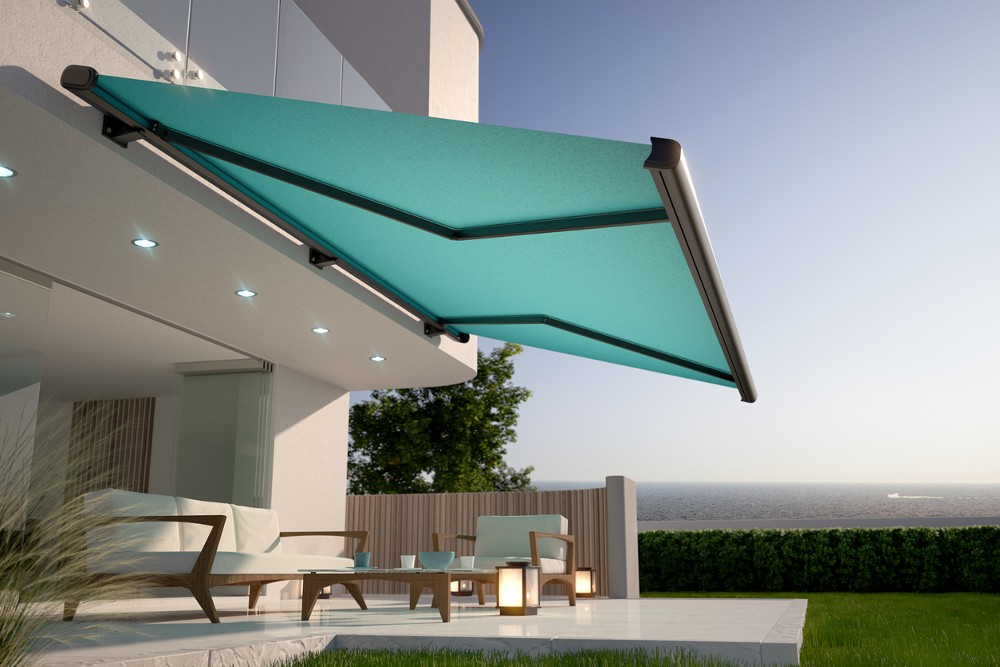
When it comes to providing shade for your outdoor living space, there are several options to choose from, such as retractable awnings, shade sails, outdoor curtains, sun shades, sail shades, cantilever umbrellas, thatched roofs, and more. In this article, we will be discussing the pros and cons of two popular options: cantilever umbrellas and thatched roofs.
Pros of Cantilever Umbrellas:
1. Flexibility – Cantilever umbrellas are designed to be easily rotated and tilted at different angles, providing maximum shade coverage and flexibility.
2. Adjustable – The canopy of a cantilever umbrella is made of durable fabric and can be adjusted to block the sun at different times of the day.
3. Space-saving – The umbrella’s unique design allows it to be positioned over outdoor furniture without interfering with the setup.
4. Easy to use – Most cantilever umbrellas come with a crank system that makes adjusting the canopy easy.
5. Durability – The canopy material is designed to withstand outdoor elements and is resistant to UV rays and water.
Cons of Cantilever Umbrellas:
1. Price – Cantilever umbrellas can be more expensive than traditional patio umbrellas.
2. Maintenance – The weighted base needs to be regularly cleaned and the canopy may need to be replaced every few years.
Pros of Thatched Roofs:
1. Aesthetic Appeal – Thatched roofs create a unique and visually pleasing look to any outdoor living space.
2. Natural – Thatched roofs are made from natural materials, such as grass or palm leaves, making them an eco-friendly option.
3. Insulation – Thatched roofs provide insulation, keeping the outdoor space cool in summer and warm in winter.
4. Durability – Thatched roofs can last up to 20 years with proper maintenance.
Cons of Thatched Roofs:
1. Expense – Thatched roofs can be very expensive to install compared to other shade structures.
2. Maintenance – Thatched roofs require regular maintenance, such as cleaning, patching, and re-thatching, to maintain their lifespan.
3. Fire Hazard – Thatched roofs are susceptible to fire and special precautions should be taken to prevent fires.
In conclusion, both cantilever umbrellas and thatched roofs provide unique benefits to outdoor living spaces. Cantilever umbrellas are a flexible and adjustable shade solution, while thatched roofs offer a natural and aesthetically pleasing option. However, the decision ultimately comes down to personal preference, budget, and maintenance preferences.
Patio Table Coverings & Permanent Structures
When it comes to creating a comfortable and functional outdoor living space, many homeowners turn to their patio. This area can serve as an extension of your indoor living space, providing a place to relax, dine and entertain guests. But when the blazing sun beats down on your patio, it can be hard to enjoy your time outdoors. That’s where patio table coverings and permanent structures can make a world of difference.
Patio table coverings can be a simple and cost-effective way to add much-needed shade to your outdoor space. These covers come in a variety of styles, materials, and sizes to fit any patio table. Some covers are made from waterproof material to protect your outdoor furniture from the elements, while others are designed to block the sun’s harmful UV rays.
A permanent structure like a pergola or patio cover can not only provide ample shade for your patio but also add some aesthetic appeal. These structures can be made of a variety of materials like wood, vinyl, or aluminum, and can be designed to fit any style or theme. A pergola, for example, is a versatile and stylish option that can add height and dimension to your outdoor space. It’s a great way to create a covered area that still allows natural light to filter through.
If you’re looking for something more substantial, a patio cover could be the perfect solution. These coverings are attached to the exterior of your home and provide full coverage for your patio. They can be designed in a variety of styles to match your home’s architecture and provide maximum shade.
When choosing between patio table coverings and permanent structures, it’s important to consider your budget, aesthetic preferences, and the climate of your area. Your choice will depend on how much shade you need, how much maintenance you’re willing to do and how much you’re willing to spend.
No matter which option you choose, adding shade to your patio can enhance your outdoor living experience and add value to your home. So whether you opt for a simple table covering or a more permanent structure, you can enjoy your outdoor space all season long.

